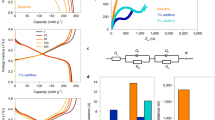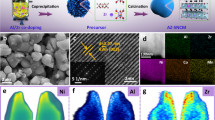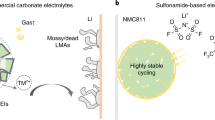Abstract
Nickel-rich layered lithium transition-metal oxides, LiNi1−xMxO2 (M = transition metal), have been under intense investigation as high-energy cathode materials for rechargeable lithium batteries because of their high specific capacity and relatively low cost1,2,3. However, the commercial deployment of nickel-rich oxides has been severely hindered by their intrinsic poor thermal stability at the fully charged state and insufficient cycle life, especially at elevated temperatures1,2,3,4,5,6. Here, we report a nickel-rich lithium transition-metal oxide with a very high capacity (215 mA h g−1), where the nickel concentration decreases linearly whereas the manganese concentration increases linearly from the centre to the outer layer of each particle. Using this nano-functional full-gradient approach, we are able to harness the high energy density of the nickel-rich core and the high thermal stability and long life of the manganese-rich outer layers. Moreover, the micrometre-size secondary particles of this cathode material are composed of aligned needle-like nanosize primary particles, resulting in a high rate capability. The experimental results suggest that this nano-functional full-gradient cathode material is promising for applications that require high energy, long calendar life and excellent abuse tolerance such as electric vehicles.
This is a preview of subscription content, access via your institution
Access options
Subscribe to this journal
Receive 12 print issues and online access
$259.00 per year
only $21.58 per issue
Buy this article
- Purchase on Springer Link
- Instant access to full article PDF
Prices may be subject to local taxes which are calculated during checkout





Similar content being viewed by others
References
Dunn, B., Kamath, H. & Tarascon, J. M. Electrical energy storage for the grid: A battery of choices. Science 334, 928–935 (2011).
Liu, C., Li, F., Ma, L. P. & Cheng, H. M. Advanced materials for energy storage. Adv. Mater. 22, E28–E62 (2010).
Scrosati, B. & Garche, J. Lithium batteries: Status, prospects and future. J. Power Sources 195, 2419–2430 (2010).
Goodenough, J. B. & Kim, Y. Challenges for rechargeable Li batteries. Chem. Mater. 22, 587–603 (2010).
Etacheri, V., Marom, R., Elazari, R., Salitra, G. & Aurbach, D. Challenges in the development of advanced Li-ion batteries: A review. Energ. Environ. Sci. 4, 3243–3262 (2011).
Bandhauer, T. M., Garimella, S. & Fuller, T. F. A critical review of thermal issues in lithium–ion batteries. J. Electrochem. Soc. 158, R1–R25 (2011).
MacNeil, D. D., Lu, Z. & Dahn, J. R. Structure and electrochemistry of Li[NixCo1−2xMnx]O2 (0< = x< = 1/2). J. Electrochem. Soc. 149, A1332–A1336 (2002).
Hwang, B. J., Tsai, Y. W., Carlier, D. & Ceder, G. A combined computational/experimental study on Li[Ni1/3Co1/3Mn1/3]O2 . Chem. Mater. 15, 3676–3682 (2003).
Kim, M. G., Shin, H. J., Kim, J. H., Park, S. H. & Sun, Y. K. XAS investigation of inhomogeneous metal-oxygen bond covalency in bulk and surface for charge compensation in Li-ion battery cathode Li[Ni1/3Co1/3Mn1/3]O2 material. J. Electrochem. Soc. 152, A1320–A1328 (2005).
Chen, Z. H., Lee, D. J., Sun, Y-K. & Amine, K. Advanced cathode materials for lithium–ion batteries. Mater. Res. Soc. Bull. 36, 498–505 (2011).
Sun, Y-K. et al. Synthesis and characterization of Li[(Ni0.8Co0.1Mn0.1)0.8(Ni0.5Mn0.5)0.2]O2 with the microscale core-shell structure as the positive electrode material for lithium batteries. J. Am. Chem. Soc. 127, 13411–13418 (2005).
Sun, Y-K., Myung, S-T., Park, B-C. & Amine, K. Synthesis of spherical nano- to microscale core-shell particles Li[(Ni0.8Co0.1Mn0.1)1−x(Ni0.5Mn0.5)x]O2 and their applications to lithium batteries. Chem. Mater. 18, 5199–5163 (2006).
Sun, Y-K. et al. Novel core-shell-structured Li[(Ni0.8Co0.2)0.8(Ni0.5Mn0.5)0.2]O2 via coprecipitation as positive electrode material for lithium secondary batteries. J. Phys. Chem. B 110, 6810–6815 (2006).
Sun, Y-K. et al. High-energy cathode material for long-life and safe lithium batteries. Nature Mater. 8, 320–324 (2009).
Sun, Y-K. et al. A novel cathode material with a concentration-gradient for high-energy and safe lithium–ion batteries. Adv. Funct. Mater. 20, 485–491 (2010).
Sun, Y-K. et al. A novel concentration-gradient Li[Ni0.83Co0.07Mn0.10]O2 cathode material for high-energy lithium–ion batteries. J. Mater. Chem. 21, 10108–10112 (2011).
Berhan, L. & Sastry, A. M. Modeling percolation in high-aspect-ratio fiber systems. II. The effect of waviness on the percolation onset. Phys. Rev. E 75, 041121–041127 (2007).
Shaju, K. M., Rao, G. V. S. & Chowdari, B. V. R. Li ion kinetic studies on spinel cathodes, Li(M1/6Mn11/6)O4 (M = Mn, Co, CoAl) by GITT and EIS. J. Mater. Chem. 13, 106–113 (2003).
Chen, Z. H. et al. Solid state synthesis of LiFePO4 studied by in situ high energy X-ray diffraction. J. Mater. Chem. 21, 5604–5609 (2011).
Chen, Z. H. et al. Multi-scale study of thermal stability of lithiated graphite. Energ. Environ. Sci. 4, 4023–4030 (2011).
Ahn, D. et al. Suppression of structural degradation of LiNi0.9Co0.1O2 cathode at 90 °C by AlPO4-nanoparticle coating. Current Appl. Phys. 7, 172–175 (2007).
Lee, M-H., Kang, Y-J., Myung, S-T. & Sun, Y-K. Synthetic optimization of Li[Ni1/3Co1/3Mn1/3]O2 via co-precipitation. Electrochim. Acta 50, 939–848 (2004).
Hammersley, A. P., Svensson, S. O., Hanfland, M., Fitch, A. N. & Hausermann, D. Two-dimensional detector software: From real detector to idealised image or two-theta scan. High Pressure Res. 14, 235–248 (1996).
Acknowledgements
This work was supported by the Human Resources Development of the Korea Institute of Energy Technology Evaluation and Planning (KETEP) grant funded by the Korea government Ministry of Knowledge Economy (No. 20114010203150) and the National Research Foundation of KOREA (NRF) grant funded by the Korea government (MEST; No. 2009-0092780). Research at Argonne National Laboratory was funded by the US Department of Energy, EERE Vehicle Technologies Program. Argonne National Laboratory is operated for the US Department of Energy by UChicago Argonne, LLC, under contract DE-AC02-06CH11357. The authors also acknowledge the use of the Advanced Photon Source of Argonne National Laboratory supported by the US Department of Energy, Office of Science, Office of Basic Energy Sciences.
Author information
Authors and Affiliations
Contributions
Y-K.S. and K.A. proposed the concept. Z.C., H-J.N., D-J.L., H-G.J., S-T.M., C.S.Y., Y.R. and S.W. performed the experiments and acquired the data. Y-K.S., Z.C. and K.A. wrote the paper.
Corresponding authors
Ethics declarations
Competing interests
The authors declare no competing financial interests.
Supplementary information
Supplementary Information
Supplementary Information (PDF 2560 kb)
Rights and permissions
About this article
Cite this article
Sun, YK., Chen, Z., Noh, HJ. et al. Nanostructured high-energy cathode materials for advanced lithium batteries. Nature Mater 11, 942–947 (2012). https://doi.org/10.1038/nmat3435
Received:
Accepted:
Published:
Issue Date:
DOI: https://doi.org/10.1038/nmat3435
This article is cited by
-
Preparation of NCM622 cathode materials using nanoscale porous NiO material
Ionics (2024)
-
Morphology controlled performance of ternary layered oxide cathodes
Communications Materials (2023)
-
B-doped nickel-rich ternary cathode material for lithium-ion batteries with excellent rate performance
Ionics (2023)
-
Enhanced cycling stability of single-crystal LiNi0.83Co0.07Mn0.10O2 by Li-reactive coating with H3BO3
Rare Metals (2023)
-
AlF3 coating improves cycle and voltage decay of Li-rich manganese oxides
Journal of Materials Science (2023)



